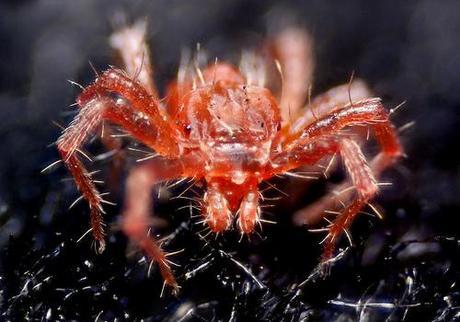One day, you go to look at your garden either indoor or out and you notice that your leaves have started to get some yellow spots. Maybe you notice the leaves are curling or you see some very fine spider webs starting at the inner nodes of your plants. Tetranychus Urticae is also known as the “twospotted spider mite” or “red spider mite”.
Originating in Eurasia, Tetranychus Urticae has quickly spread around the globe due to globalization. These little, as small as 1/32″, relatives of spiders will do everything in their power to suck every last drop of liquid from your plants. Tetranychus Urticae is an incredibly hardy and reproductive garden pest. Part of the reason the red spider mite is so hardy is due to it’s extreme reproductive prowess. Red mites flourish at temperatures around 90 degrees Fahrenheit and very low humidity. In fact, when the environment is right Tetranychus Urticae can go from egg to mature breeding adult female in only 3 days.

Once fully mature, the Tetranychus Urticae will lay approximately 20 eggs a day until the day she dies, which, is in 2-4 weeks. To add insult to injury, even if a Tetranychus Urticae is not fertilized she will still lay eggs, that will hatch into male mites. This means that with even less than ideal conditions the red spider mite population can explode exponentially if left unchecked.
Inspect for Tetranychus Urticae
To ensure that your hard work is not in vain you should check your plants often. This means:
- Inspect tops of leaves of plant. Do any of these signs exist?
- Small yellow dots on leaves
- What looks like a grainy dust on leaves
- Leaves are curling downward
2. Inspect bottoms of leaves on plant. With magnifying glass if possible.
- Small, clear dots on leaves (Tetranychus Urticae eggs)
- Little dots that are moving (Tetranychus Urticae)
- Webbing
3. Inspect intersections of leaves and branches and trunk
- Fine webbing
- On webbing, any moving dots
If you find ANY sign of Tetranychus Urticae you should start treatment ASAP. If you dont see any sign of red spider mites you should still start preventitive measures.
Preventing Tetranychus Urticae
Preventing Tetranychus Urticae is in theory relatively easy. In THEORY. The easiest way to prevent red spider mites is to
- Get a sprayer such as the Solo 420 2-Liter One-Hand Pressure Sprayer
- Get 3 at least 3 chemicals with different modes of action. I suggest: Dyna-Gro Nem-032 Neem Oil Leaf Polish Azatrol EC Insecticide 4 ounce – OMRI Listed Organic Monterey LG6135 Garden Insect Spray
- Get a surfactant such as Advanced Nutrients Wet Betty Organic
- Spray with one chemical and wetting agent once per week. Rotate chemicals to prevent any chance of Tetranychus Urticae building a resistance.
If you have plants that are not going to be ingested such as ornamentals and you are not opposed to non-organic treatment then products such as Avid 0.15ECand Forbid 4F Miticide in conjunction with your other products would give you lasting protection.
Treating a Tetranychus Urticae infestation
If you inspect your plants and realize that they are already infected, you need to react fast. Red spider mites are extremely difficult to treat once they are established. Mites become resistant to chemicals quickly, because survivors of treatments breed more resistant Tetranychus Urticae which in turn breed quickly.
Treatment for established Tetranychus Urticae colonies is much the same as for prevention with the key difference being the frequency of treatment. Treating your plants every 3 days is critical because it is the same cycle they are born on. Killing them as soon as they hatch, before they have time to lay eggs. You will want to continue this cycle of treatment for at least a month after all mites have died.
In addition to the organic Sprays it is HIGHLY recommended to use Avid 0.15EC and Forbid 4F when dealling with established Tetranychus Urticae populations.
For more information on Tetranychus Urticae visit
Tetranychus Urticae aka Spider Mite
